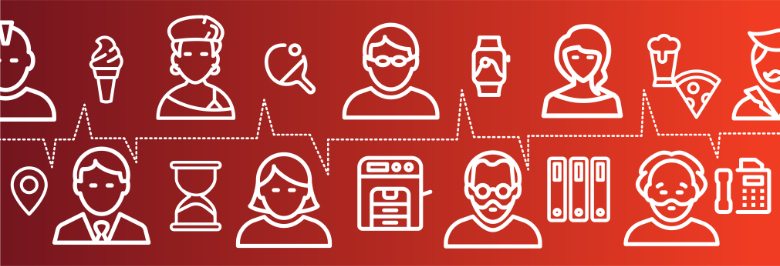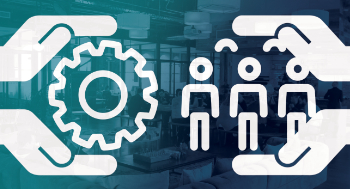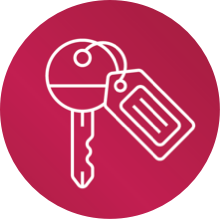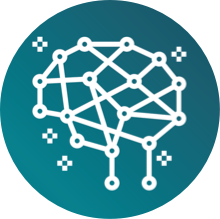Feeling like just a number?

The importance of how we choose to count
Nothing ruins a holiday dinner faster than grown adults fighting over the last of the mashed potatoes. If you’re making a big, fancy dinner (or having it delivered), the guest-count is a pretty essential piece of information. Without this critical data, someone is going home disappointed—and maybe hungry! In this month’s “On Our Minds”, we dig into what can go wrong when people are underrepresented by data, or even left out entirely! Scroll on…
On our minds
As you probably know by now, we love data: big data, little data, and everything in between. It’s exciting to see how quickly data sources and analysis tools are multiplying, presenting new opportunities for improving the workplace experience. However, with so much focus on the possibilities presented by this smorgasbord, it’s easy to forget about what’s missing—which is actually quite a lot.
For all of the data at our fingertips, it’s still only possible to see the tiniest sliver of our multifaceted, multisensory human experience. Much of what people do and how they feel remains a mystery—mere shadows (with apologies to Plato) on the wall of a cubicle. While much of this data may not be germaine to a person’s or organization’s ability to perform, some of it clearly is. (This conversation of basic inclusion should live beyond our recent celebration of World Toilet Day.) Our contention is that this dearth of data is at least as much a result of design and leadership priorities as it is a result of insufficient resources. Its about who seeks data, what we are looking for and how we both analize and act on that data.
This same disconnect exists on a larger scale, too. While people in connected urban centers are being counted, monitored, tracked, and analyzed at ever-greater levels of detail for an ever-expanding range of purposes, this is not the case everywhere. There are plenty of people about whom there is very little data. In opening remarks at this year’s Bloomberg Data for Good Exchange, Francesca Perucci, Assistant Director of the UN Statistics Division and Claire Melamed, CEO of Global Partnership for Sustainable Development Data, focused on the global impacts of this by pointing out that as many as 7% of the world’s people are not included in any datasets at all. That’s around half a billion people, many of them amongst the most marginalized, who are not being counted.
Being counted is not a trivial thing. It’s common sense that someone who is not represented in data is probably not going to be supported very well in a world that is increasingly data-driven. It automatically puts those people at a disadvantage. Even in situations that ostensibly should count everyone, such as voting, there is a troubling lack of investment in ensuring that this is accomplished accurately. There is also a general lack of attention to the role of design in shaping the way people have their votes counted, as was highlighted in a recent event hosted by AIANY. Some of these problems could (and should) be addressed through design and resource allocation.
n any workplace, some people are probably having an experience that is less than ideal, but that feedback may not be showing up in the data. How can you make sure that they are having their "votes counted", so to speak? Technology offers a lot of new tools, many of them designed to do exactly that—room booking apps, surveys, and building systems data can reveal much about what people want or need. But the key element here is intent; the decision about who and what to measure is itself a declaration of priorities. This is likely why some of our favorites, like Physics Toolbox, Comfy or Fitbit, reflect more of a Self Quant model.
When understanding the experience of people is not a primary goal of a data effort, the whole business can suffer in ways that might not immediately be visible. Take, for example, data about employee engagement. Despite research that suggests that employee engagement is one of the top drivers of the success of a company, and despite the fact that there are agreed-upon ways to measure it, engagement is still regularly left out of high-level discussions about workplace and real-estate strategy. This is a symptom of a top-down approach to data that is driven by what the people in charge deem to be important, rather than the needs and preferences of individual employees.
It is not always possible or desirable to give people everything they want, but it is far better to at least know what the desired state is. As we highlight in our recent piece about change management in Work Design Magazine, the optimal solution to a workplace issue is often not visible from the starting line. It requires a collaborative dialogue between leaders and the people they lead. If that exchange is to be effective, the data that underpins it must be representative of the lived experience of the people being measured.
To that end, we think it’s helpful to rethink the directionality of data. Often, people are being measured or counted by some central authority—be it the leadership of a company, a branch of the government, or an international NGO—with some goal already in mind. However, these institutions aren’t the only ones who take measurements. Individual people count things too. They can (and do) use their phones to measure things like the level of distracting noise in their offices. People count the minutes they spend getting to work every morning, the hours they spend in meetings every week, and the days since their last positive engagement with their manager. We all count the things that matter to us.
So, if the goal is to become more inclusive in our approach to data, consider starting with a new question. Connect with an individual employee and ask: what are you counting?
From the archives
Last November, we enjoyed a fascinating panel, "Architects as Activists", which explored the many ways that design can play a role in making the world more equitable and empowering for all. We were glad to support this event as part of our long history of engagement with the AIANY Social Science and Architecture Committee.
Back in 2015, we wrote about our work supporting Mozilla’s fail-fast approach to workplace. By embracing the kinds of failure that lead to learning, they allow for a real estate strategy that is flexible, iterative, and adaptable.
That about does it for this month, but you’re always welcome at our table. Drop us a line to share your go-to holiday recipes or party plans. Hope to see you this season!
In Case You Missed It
This month, we’ve been thinking a lot about data, privacy, and design. Here are a few of the fascinating talks and articles that have been top-of-mind.

Vote! Process and Place
The AIANY Center for Architecture hosted civic leaders and election experts to discuss how the design of polling places and policies shapes civic participation.

Generative Design Overview
Our computational design loving friends at Proving Ground highlight some of the tools and techniques advancing the practice.

Ergonomic Tracking: Safety Boon or Intrusive Surveillance?
Ubiquitous sensors can help prevent injuries in the workplace. But not everyone wants to be tracked.

How Boeing Lost its Bearings
This in-depth piece traces troubles at the aerospace giant to the decision to move its headquarters to another city, leaving its engineering-first culture behind.

Google’s Healthcare Research Raises Flags
Recent reporting has raised concerns about the role of big tech in medicine, particularly with regard to privacy.

The Norwegian Secret to Enjoying a Long Winter
If you’re in the northern hemisphere, colder and shorter days are ahead. Conquer winter blues like the Norwegians do!
Looking Ahead
We’re thankful for so many opportunities to learn, grow, and share the latest in work and workplace. Here’s hoping we see you before the year is out!





